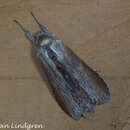Distribution
fornì da University of Alberta Museums
A widespread moth, found from Newfoundland south through central southern BC south to UT. New England in the east to Vancouver Island in the west and south to central NV, northern AZ and CO. In Alberta it has apparently been collected only along the mountains, from the Crowsnest Pass area north to Nordegg.
- licensa
- cc-by-nc
- drit d'autor
- University of Alberta Museums
General Description
fornì da University of Alberta Museums
A medium-size (approximately 4.6-5.0 cm. wingspan) long-winged moth dark grey moth. Most similar to C. florea, but omissa has the costa and lower margin of the forewings darker than the rest of the wing (more evenly colored in florea) and a diffuse brown shade running from the orbicular spot to the apex. Cucullia similaris is paler grey with more contrasting spots. There are also differences in the genitalia. Poole (1995) illustrates the adults and the genitalia of both sexes.
- licensa
- cc-by-nc
- drit d'autor
- University of Alberta Museums
Habitat
fornì da University of Alberta Museums
We know little of its specific habitat, but it likely occurs in meadows and other open habitats, including openings in wooded areas.
- licensa
- cc-by-nc
- drit d'autor
- University of Alberta Museums
Life Cycle
fornì da University of Alberta Museums
There is a single annual brood, with adults in early summer (late June - mid July). Like other Cucullia species, the adults are nocturnal and they come to light. The early stages have not been described. There is a single host plant record from Nova Scotia, where a specimen was reared from a larva on Aster umbellatus (Mill.) (Asteraceae) (Poole, 1995)
- licensa
- cc-by-nc
- drit d'autor
- University of Alberta Museums

